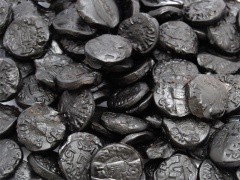Liquorice
| Infobox on Liquorice | |
|---|---|
| Example of Liquorice |  |
| Facts | |
| Origin | - |
| Stowage factor (in m3/t) | - |
| Humidity / moisture | - |
| Oil content | - |
| Ventilation | - |
| Risk factors | - |
Liquorice
Description
Liquorice is a confectionery flavoured with the extract of the roots of the liquorice plant. A wide variety of liquorice sweets are produced around the world. In North America, liquorice is called black licorice, to distinguish it from similar confectionery varieties that are not flavoured with liquorice extract, and commonly manufactured in the form of chewy ropes or tubes. In addition to these, various other liquorice-based sweets are sold in the United Kingdom, such as liquorice allsorts. Dutch and Nordic liquorice characteristically contains ammonium chloride instead of sodium chloride, prominently so in salty liquorice.
The essential ingredients of liquorice candy are liquorice extract, sugar, and a binder. The binder is typically starch/flour, Gum Arabic, or gelatin, or a combination thereof. Additional ingredients are extra flavouring, beeswax for a shiny surface, ammonium chloride, and molasses to give the end product the familiar black colour. Ammonium chloride is mainly used in salty liquorice candy, with concentrations up to about 8 percent. However, even regular liquorice candy can contain up to 2% ammonium chloride, the taste of which is less prominent due to the higher sugar concentration. Some "liquorice" candy is flavoured with anise oil instead of or in combination with liquorice root extract.
Liquorice grows best in deep, fertile, well-drained soils, with full sun, and is harvested in the autumn, two to three years after planting.
Liquorice extract is produced by boiling liquorice root and subsequently evaporating most of the water. Liquorice extract is traded both in solid and syrup form. Its active principle is glycyrrhizin, a sweetener between 30 to 50 times as sweet as sucrose which also has pharmaceutical effects.
Liquorice flavour is found in a wide variety of liquorice candies. The most popular in the United Kingdom are liquorice allsorts. In continental Europe, however, far stronger, saltier candies are preferred. In most of these candies the taste is reinforced by aniseed oil, and the actual content of liquorice is very low.
In the Netherlands, where liquorice candy ("drop") is one of the most popular forms of sweet, only a few of the many forms that are sold contain aniseed (although mixing it with mint, menthol or with laurel is popular, and mixing it with ammonium chloride creates the very popular salty liquorice known in Dutch as ‘zoute drop’.
In many countries there is also a product sometimes known as red liquorice, which is extruded in a way to resemble liquorice strings, but made with strawberry, cherry, raspberry, or cinnamon flavourings as the main flavourings rather than liquorice. More recently similar products have been introduced in a wider variety of colours and flavours including apple, mango, blackcurrant, and watermelon, among others.
Shipment / Storage / Risk factors
Liquorice is usually shipped in bales. Excess moisture will render this commodity mouldy. The extract of the liquorice root shipped as a liquid or solid in barrels or cases. Liquorice extract in solid form should be stored away from heat to prevent softening and consequent running.











